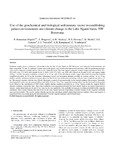| dc.description.abstract | [Please note chemical formulae do not display correctly in this abstract]. Sediment samples from a continuous 4.6m profile in the dry bed of Lake Ngami in NW Botswana were analysed for geochemistry and dated using both 14C and TL methods. Certain units in the profile were found to be diatom rich and these, with the geochemical results, were used as indicators of high and low lake levels within the basin. The Lake Ngami sediments contain a high proportion of SiO2 (51-92.5 wt%, avg. 72.4 wt%) and variable levels of Al2O3 (2.04-17.2 wt%, avg. 8.88 wt%). Based on elevated Al2O3 and organic matter (LOIorgc) results, lacustrine conditions occurred at ca. 42 ka until 40 ka and diatom results suggest that relatively deep but brackish conditions prevailed. At 40 ka, the lacustrine sedimentary record was terminated abruptly, possibly by tectonic activity. At ca. 19 ka, shallow, aerobic, turbulent conditions were prevalent, but lake levels were at this time increasing to deeper water conditions up until ca. 17 ka. This period coincides with the Late Glacial Maximum, a period of increased aridity in the central southern Africa region. Generally, increasing Sr/Ca ratios and decreasing LOIorgc and Al2O3, from ca. 16 to 5 ka, suggest decreasing inflow into the basin and declining lake levels. Based on the enrichment of LREE results, slightly alkaline conditions prevailed at ca. 12 ka. Diatom results also support shallow alkaline conditions around this time. These lake conditions were maintained primarily by local rainfall input as the region experienced a warmer, wetter phase between 16 and 11 ka. Lake levels rose rapidly by 4 ka, probably in response to enhanced rainfall in the Angolan catchment. These results indicate that lake levels in the Lake Ngami basin are responding to rainfall changes in the Angolan catchment area and local rainfall. The results confirm that the present-day anti-phase rainfall relationship between southern Africa and regions of equatorial Africa was extant during the late Quaternary over the Angolan highlands and NW Botswana. | en |

